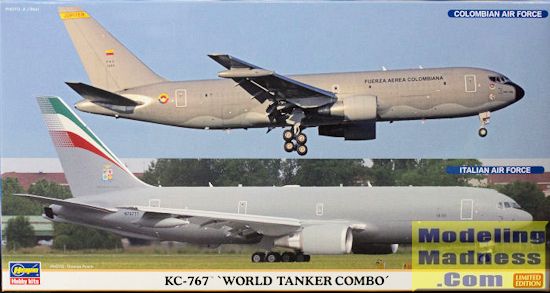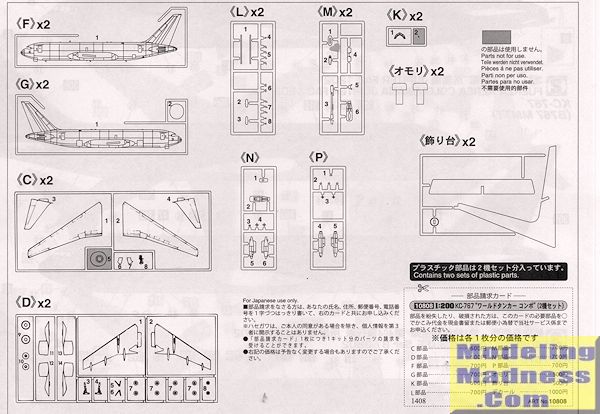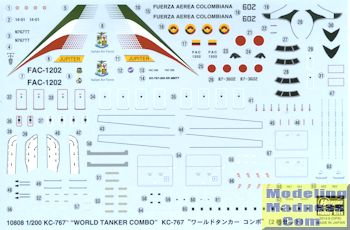
Hasegawa 1/200 KC-767 'World Tanker Combo'
| KIT #: | 10808 |
| PRICE: |
2800 yen from www.hlj.com (about $24.00) (3600 yen SRP) |
| DECALS: | Three options |
| REVIEWER: | Scott Van Aken |
| NOTES: | Two kits in the box |

| HISTORY |
KC-767 Advanced Tanker – the 767-200ER-based aerial tanker developed for the USAF KC-X tanker competition. It is an updated version of the KC-767, originally selected as the USAF's new tanker aircraft in 2003, designated KC-767A, and then dropped amid conflict of interest allegations. The KC-767 Advanced Tanker is derived from studies for a longer-range cargo version of the 767-200ER, and features a fly-by-wire refueling boom, a remote vision refueling system, and a 767-400ER-based flight deck with LCD screens and head-up displays. Boeing was awarded the KC-X contract to build a 767-based tanker, to be designated KC-46A, in February 2011.
KC-767 Tanker Transport – the 767-200ER-based aerial refueling platform operated by the Italian Air Force (Aeronautica Militare), and the Japan Self-Defense Forces. Modifications conducted by Boeing Integrated Defense Systems include the addition of a fly-by-wire refueling boom, strengthened flaps, and optional auxiliary fuel tanks, as well as structural reinforcement and modified avionics. All four KC-767Js ordered by Japan have been delivered. The Aeronautica Militare received the first of its four KC-767As in January 2011 and is now fully equipped.
The Colombian Air Force operates one 767 MMTT, an aircraft converted by IAI from a standard airliner. This aircraft does not have the flying boom, only wing pod drogues. A similar conversion is underway for the Brazilian Air Force. These are not specifically K767s.
| THE KIT |
 So what you get
in the box are two complete kits, something I've seen more and more from
Hasegawa. It is a smart marketing scheme as it allows them to produce another
boxing but also allows the buyer to get a bit of a discount over what it would
cost to buy two of the same kit.
So what you get
in the box are two complete kits, something I've seen more and more from
Hasegawa. It is a smart marketing scheme as it allows them to produce another
boxing but also allows the buyer to get a bit of a discount over what it would
cost to buy two of the same kit.
Hasegawa was foremost in touting 1/200 scale for airliners and similar large aircraft and has produced quite a few kits in this scale. This is basically their 767-200 with additional sprues to allow you to do the tanker version. I would not be surprised to see a KC-46A boxing when that plane starts rolling off the assembly lines.
Hasegawa has produced basically two series of airliners. The initial series was raised panel lines as was vogue during that time. Those kits came with large screws to use for nose weight and could only be built out of the box with the wheels down. They also had window openings molded into the fuselage. The fuselages were split vertically.
The latest airliner kits or their second generation kits, have horizontally split fuselages and have additional gear door pieces so the planes can be built gear up. They also take advantage of slide molding and the engines are generally cast in a single piece, making the hassle of filling lip seams a thing of the past.
This kit is a first generation kit though modified. It basically improves on the first generation moldings by having engraved panel lines and smooth fuselage sides, relying on decals for the windows. It still has multi-piece engines, vertically split fuselage, raised panel lines on the wings, tailplanes and engines, and is not molded so that one can have it in flight. It also comes with two large screws for nose weight.
In addition to the standard airliner bits, Hasegawa has included the flying boom as well as two different styles of wingtip pods. There are also a lot of additional antennas for the fuselage which are not carried by the airliner. While the cockpit windows are clear, you are also provided with decals to fit over that area if you so desire. The builder will need to fill in some panel lines as these planes have cargo doors that will need to be added (decals are provided for those doors).
 Instructions
are nicely done and use Gunze paint references. Over the last year or so,
Hasegawa has started naming the parts in their instructions, which is nice to
see. There are three markings options. One is a Japanese KC-767 in overall light
gull grey. This one has a refueling boom. The other with a refueling boom is the
Italian option in overall FS 36270. This is the initial plane in the order and
carries a civil registration for when it was being tested in the US. The
in-service plane will be without this item. The third is the 767MMTT for the
Colombian Air Force. This plane has no refueling boom and is in FS 36270 over
36375 with a wavy demarcation line. The instructions show all the landing gear
and inner gear doors in FS 16440, but they are probably actually Boeing Grey.
The decals themselves are superbly printed and are Hasegawa new age markings so
will be very thin. All the various slime lights, stencils and other markings are
included on the sheet and there are enough for two planes.
Instructions
are nicely done and use Gunze paint references. Over the last year or so,
Hasegawa has started naming the parts in their instructions, which is nice to
see. There are three markings options. One is a Japanese KC-767 in overall light
gull grey. This one has a refueling boom. The other with a refueling boom is the
Italian option in overall FS 36270. This is the initial plane in the order and
carries a civil registration for when it was being tested in the US. The
in-service plane will be without this item. The third is the 767MMTT for the
Colombian Air Force. This plane has no refueling boom and is in FS 36270 over
36375 with a wavy demarcation line. The instructions show all the landing gear
and inner gear doors in FS 16440, but they are probably actually Boeing Grey.
The decals themselves are superbly printed and are Hasegawa new age markings so
will be very thin. All the various slime lights, stencils and other markings are
included on the sheet and there are enough for two planes.
| CONCLUSIONS |
With this type of plane becoming more and more common with the world's air forces, it is nice to see this being kitted. The kit covers 75% of the current 767 tanker operators with only the Brazilian one (which has probably not yet been completed), as the one left off. These are really very nice kits and 1/200 scale means you can display them without them overwhelming your display space. I have built the 767-200 airliner and found it to be a pleasant building experience.
| REFERENCES |
http://en.wikipedia.org/wiki/Boeing_767
April 2015 Thanks to www.hlj.com
for the preview kit. You can find this kit at this link. If you would like your product reviewed fairly and fairly quickly, please
contact
the editor or see other details in the
Note to
Contributors.